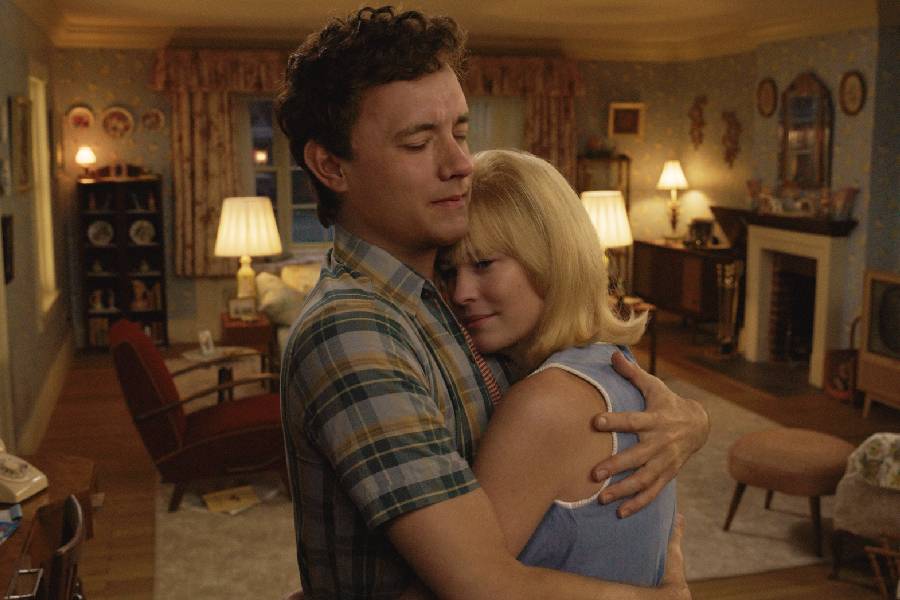“Here” Falls Short with Unexplored Concepts and Neglected Set Design

A Disappointment in Cinematic Innovation: A Review of Robert Zemeckis's “Here”
On November 1, 2024, the much-anticipated film “Here,” directed by the renowned Robert Zemeckis, hit theaters, bringing with it the promise of cinematic brilliance. Zemeckis, celebrated for his iconic works such as “Forrest Gump” and “Back to the Future,” re-teams with heavyweights Tom Hanks and Robin Wright for a film that could have been a masterclass in storytelling. However, audiences leaving the theater were met not with applause but with a collective shrug of indifference—a sentiment echoed by a tepid 2.0 out of 5-star rating from early reviews.
At its core, “Here” attempts to explore the intertwining narratives of three generations of the Young family, set against the backdrop of a single home. The film’s unique premise, where the camera remains fixed for the entire runtime, is an ambitious concept aimed at capturing the passage of time in a single setting. Unfortunately, while the idea is intriguing, the execution stumbles and falters, leaving viewers feeling confused more often than engaged.
The film opens with a sweeping montage that showcases the end of the Jurassic era, deftly transitioning into the construction of a home that will witness countless lives unfold within its walls. While the concept has promise and potential for deep emotional exploration, the execution falls short. The narrative jumps around different eras, presenting fragmented vignettes of the family’s life rather than a cohesive arc. This lack of clarity can detract from what could have been a poignant exploration of change, memory, and continuity.
The film introduces us to Al Young (Paul Bettany) and Rose Young (Kelly Reilly), whose initial 20 minutes set the stage for their burgeoning family life. The focus then shifts to their son, Richard Young, played by Hanks, navigating the tumultuous waters of life alongside his pregnant girlfriend-turned-wife, Margaret, portrayed by Wright. However, such poignant moments are often overshadowed by jarring time jumps and disconnected subplots, including brief appearances from historical figures, which only muddle the narrative further.
One of the film’s main shortcomings is its serious tone. Amid the grandeur of its ambition lies a desperate need to appear profound, yet it often lacks the emotional depth to back this up. Each familial snapshot is truncated prematurely, leaving characters and their predicaments feeling one-dimensional. For instance, the inclusion of the La-Z-Boy inventor’s story, albeit entertaining, ultimately feels like a distraction rather than an integral part of the narrative tapestry.
The ambitious structuring also leads to a haphazard pace that undermines any potential emotional impact. For every touching moment—a fleeting interaction between two indigenous characters or the bittersweet reminiscence of Hanks’s character—there’s an equally bewildering encounter that merely serves as filler. This inconsistency not only detracts from character development but also makes it hard for viewers to invest emotionally in the Young family’s dramas.
Despite the disappointing storytelling, the film does have its bright spots. Visually, “Here” exhibits a unique creative flair, with stunning set designs and innovative transitions. The use of little white squares that gradually occupy the screen to introduce new scenes adds an interesting visual element rarely seen in mainstream cinema. Each shift transports viewers through seasons, holidays, and decades, creating a visually rich tapestry that’s as engaging as it is ambitious. The meticulously designed living room feels like a character in its own right, bringing warmth and a sense of belonging—an ironic counterpoint to the emotional disconnect of the narrative.
However, even the visuals falter with poorly executed CGI that interrupts immersion. From awkward depictions of dinosaurs to a distracting digitally de-aged Hanks, the film’s visual hiccups detract from its otherwise creative ambitions.
Ultimately, “Here” emerges as a film teetering on the edge of brilliance yet bogged down by underdeveloped themes and inconsistent storytelling. While the film touches on universal themes related to family, loss, and the relentless passage of time, it struggles to find its footing amidst its unconventional approach. Despite its many shortcomings, “Here” shines in its ambition—a testament to Zemeckis’s creative vision. However, in its current state, it’s a missed opportunity that many viewer hearts will find difficult to connect with.
As this film trudges its way through theaters, one can’t help but ponder the potential that could have blossomed from a more carefully curated narrative. In a world inundated with stories, “Here” remains a poignant reminder that good ideas, when left underdeveloped, struggle to find a place where they can truly resonate with audiences. Whether you choose to give it a try might depend on your affinity for the talent involved—not the film itself.




